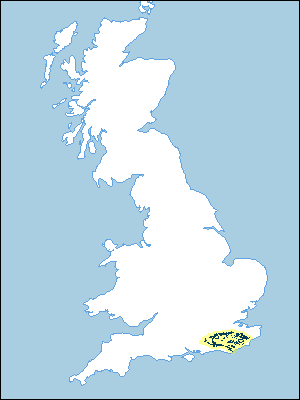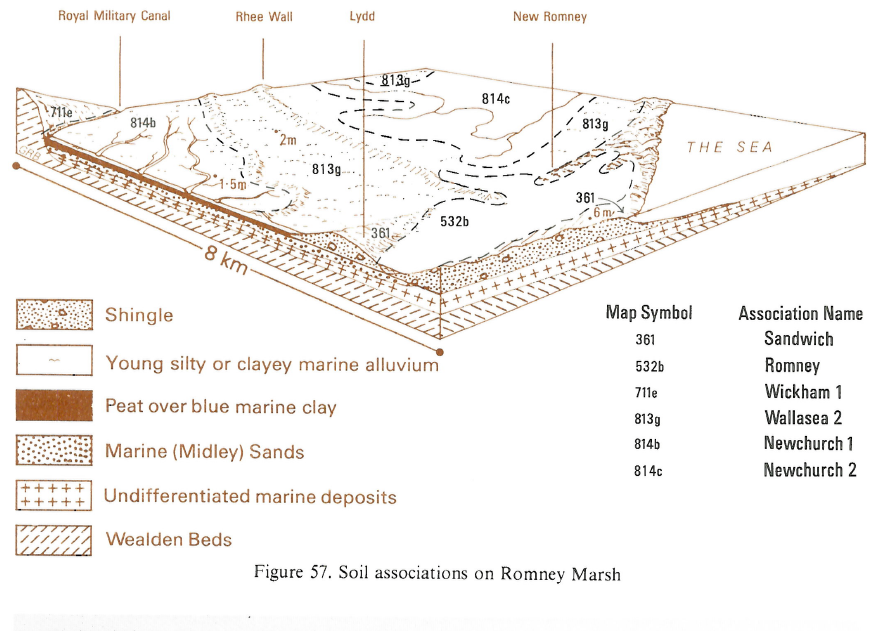
Soil Associations
0711e WICKHAM 1
Soil and site characteristics
Slowly permeable seasonally waterlogged fine silty over clayey, fine loamy over clayey and clayey soils.
Geology
Drift over Cretaceous clay or mudstone
Cropping and Land Use
Dairying on short term grassland winter cereals; much deciduous woodland in the High Weald of Kent and Sussex.
Component soil series
| Subgroup | Series name | Percentage | WRB 2006 link |
|---|---|---|---|
| 7.11 | WICKHAM | 45% | Eutric Luvic Planosols |
| 7.12 | DENCHWORTH | 15% | Eutric Vertic Stagnosols |
| 7.12 | DALE | 15% | Clayic Eutric Stagnosols |
| 5.72 | OXPASTURE | 10% | Endostagnic Luvisols |
Covers 1593 km2 in England and Wales
Soilscapes Classification
| 18 |
Slowly permeable seasonally wet slightly acid but base-rich loamy and clayey soils |
0711e WICKHAM 1
Detailed Description
This association, which is confined to Kent, Surrey and Sussex, is the most extensive in the Low Weald where intermittent thin drift rests on Atherfield and Weald Clays. It also occurs in the High Weald over Wadhurst and Grinstead Clays. It includes most of the land mapped as the Thorne-Hildenborough and the Thorne-Titchfield associations in an earlier survey of Kent. In the Low Weald, the relief is subdued ranging from 30-90 m O.D. and the land is level or gently sloping with a few steeper slopes, often where thin limestone or sandstone bands outcrop. Between Tonbridge and Reigate, springs rise near the foot of the Lower Greensand scarp and dissect the Weald Clay into a series of north—south ridges with gentle or moderate slopes capped in places by flinty and cherty river terrace deposits. Relief is stronger in the High Weald (45-200 m 0.D.) with moderately to steeply sloping valley sides separated by gently sloping interfluves.
The main soils in this association are seasonally waterlogged and grey and ochreous mottled. Wickham soils are fine silty or fine loamy over clayey typical stagnogleys and Denchworth and Dale soils clayey pelo-stagnogleys. Oxpasture soils, stagnogleyic argillic brown earths, are similar to Wickham but less mottled. Wickham series includes soils previously described as Titchfield and Hildenborough series and, similarly, Denchworth and Dale soils were mapped together as Thorne series. Denchworth and Dale series differ in their clay mineralogy; Denchworth soils are developed in clays which shrink and crack appreciably on drying, and Dale soils in clays which do not. The thin fine silty bands and generally large silt content of the Weald Clay are commonly reflected in the subsoils of all the soils. Some Wickham soils have stony upper horizons.
Most of the Wickham soils have fine silty topsoils, probably remnants of aeolian silty drift, although they are thin on moderate or strong slopes. These upper horizons are variably stony, more so in the west of the Weald on ridge crests. Denchworth and Dale series occur on moderate to steep slopes and are often associated with thin limestone bands; in places these soils are dominant as in the broad belt of level or gently sloping land from Shadoxhurst, north of Tenterden, to Biddenden. Reddish Brockhurst and Spetchley soils are found sporadically throughout the Low Weald, in red beds in the Weald Clay. Oxpasture soils occur on valley sides, often where the fine loamy or fine silty drift is thicker than usual. Evesham and Haselor soils occur locally on or near thin Paludina limestone bands.
Inclusions of Curtisden and Cranbrook series occur over thin siltstone and sandstone bands, especially in the High Weald. Here, the soil pattern in valleys is made more complex than that on ridge crests by the presence of thin superficial drift, derived in part from the Tunbridge Wells Sand upslope, and Oxpasture soils are more common than elsewhere. Near Dorking, thicker sandstone layers in the Weald Clay form low ridges with some Fyfield soils. Small inclusions of Shabbington soils are developed in patches of low-lying stony Head or river terrace deposits in minor valleys and of Conway and Fladbury soils in narrow strips of alluvium too small to separate. Around Edenbridge, Waterstock soils are common on high level river terrace deposits or Head which cover the Weald Clay.
Soil Water Regime
Wickham, Denchworth and Dale series have slowly permeable subsoils and are waterlogged for long periods in winter (Wetness Class IV) when undrained. Appropriate field drainage measures achieve some improvement, though it is often difficult to reduce waterlogging substantially and the soils continue to be wet in winter (Wetness Class III or IV). Oxpasture soils also have slowly permeable subsoils, but with drainage improvements are only occasionally or seasonally waterlogged (Wetness Class II or III). Because the soils are saturated there is rapid run-off in winter and erosion can occur on moderate slopes. The soils have good reserves of available water and are slightly droughty for cereals but grass suffers seriously from drought in most years.
Cropping and Land Use
All the soils present some difficulties for landwork even after drainage treatment. Figure 69 shows the estimated machinery work days for the principal soils in south-east Surrey; in average years, spring working is very restricted and in wet years there is only a short period in autumn when the land is suitable for cultivation. Ploughing should therefore be planned for early autumn, especially on Denchworth and Dale soils, where careful timing is needed. Minimum cultivation and direct drilling techniques are used locally to till the land and plant autumn sown crops in the little time available. The limited opportunities for cultivation are reflected in land use - ley and permanent grass and winter cereals are the main crops. A little top fruit is also grown, for example near Wisborough Green in West Sussex and near Marden in Kent. The grassland is used chiefly for dairying though sheep and beef cattle are also important. There is a moderate risk of poaching, the greatest being on Denchworth and Dale soils, in higher rainfall areas or where the soils are undrained. Summer growth of grass is restricted by drought and the grazing value of some undrained permanent grass fields is reduced by rush infestation. The soils are naturally acid and require regular liming. Amounts of potassium are usually adequate but regular dressings of phosphorus fertilizer are needed.
There is much woodland on these soils, particularly in the High Weald. For new plantingsthe slowly permeable clayey subsoils restrict the choice to species tolerant of seasonally waterlogged ground including Corsican pine, Norway spruce, western hemlock and western red cedar. Shallow rooting often leads to poor growth and windthrow where exposed. Weed competition is severe on all soils and tine ploughing is needed before planting to suppress weeds and assist surface drainage.
A large proportion of the older woodland is coppiced and contains many plant species indicative of ancient origin, for example butcher's broom (Ruscus aculeatus), wild service tree (Sorbus torminalis) and hawthorn (Crataegus laevigata). Several woods in Kent, Surrey and Sussex are preserved for their scientific value. Much land is acid, but calcicole floras are developed locally on Haselor and Evesham soils. Hornbeam coppice, which occurs widely, is dominant in Ham Street Woods along with areas of coppiced hazel, sweet chestnut and oak below oak standards. Wood anemone (Anemone nemorosa), primrose (Primula vulgaris), bluebell (Hyacinthoides non-scripta) and honeysuckle (Lonicera periclymenum) are typical of the coppices, with bracken (Pteridium aquilinum) and bramble (Rubus spp.) in more open areas. Staffhurst Wood near Oxted has oak and beech woodland with hornbeam and beech coppice accompanied by holly and yew. Field maple, dog's mercury (Mercurialis perennis) and sanicle (Sanicula europaea) occur in base-rich areas. The Mens and The Cut near Wisborough Green have high forest of sessile and pedunculate oak.
0711e WICKHAM 1
Distribution Map
 |
Note that the yellow shading represents a buffer to highlight the location of very small areas of the association.
Keys to component soil series
South Eastern Region
 |
Typical Landscapes
South Eastern Region
 |
South Eastern Region
 |
South Eastern Region
 |
South Eastern Region
 |
South Eastern Region
 |
All information Copyright, Cranfield University © 2024
Citation: To use information from this web resource in your work, please cite this as follows:
Cranfield University 2024. The Soils Guide. Available: www.landis.org.uk. Cranfield University, UK. Last accessed 25/04/2024
